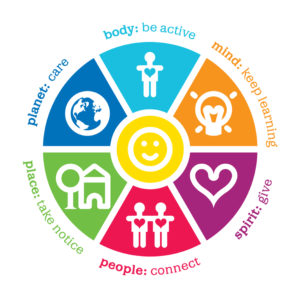This post continues the emerging conversation about the links between wellbeing and permaculture, through the lens of the Five Ways to Wellbeing. It builds on a previous blog post and workshop on wellbeing and permaculture, and invites you to share your thoughts and ideas by leaving your comments below on this post and / or on our Facebook page.
Five Ways to… Permaculture
The many links between permaculture and wellbeing include their holistic approaches to creating a world of human and natural flourishing, informed by decades’ of international research and evidence, and propelled by local and global networks of practitioners.
The Five Ways to Wellbeing are a concise summary of research into wellbeing adopted around the world, outlining five ways consistently proven to improve wellbeing: connect, be active, take notice, keep learning and give. Placing these ways to wellbeing alongside some brief summaries of key aspects of permaculture helps to further demonstrate how permaculture and wellbeing complement each other:
Connect…
Permaculture is about ‘joining the dots’ and enhancing connections, including with people and non-human nature.
Be active…
Physical and mental activity are central to permaculture. Permaculture designs also often allow simple manual tasks to replace mechanisation.
Keep learning…
Permaculture is a dynamic, on-going learning process. A design course, teaching, learning and research are all central to the permaculture movement.
Take notice…
Observation is a key practice, and the basis of all design and action, in permaculture.
Give…
The three guiding ethics of permaculture include giving back to each other and the earth: Earth Share, People Care and Fair Shares.
Joining the dots
We could explore each of the Five Ways in more depth in relation to permaculture; in this post I’ll consider Connect as a more detailed example. Whilst all Five Ways are important and work together to enhance wellbeing in a holistic way, “Connect…” is often listed as the first of the Five Ways for a reason – research shows our relationships with others are vital to our wellbeing, and the perfect antidote to the epidemic of loneliness which shortens our lives and increases our risk of disease and poor wellbeing. Furthermore, “Connect…” includes our connections with ourselves, our work, our surroundings and nature, as well as each other.
Drawing inspiration from nature, permaculture is all about connections, ‘joini
ng the dots’, is a phrase often used within permaculture training and practice. Permaculture designs consciously enhance connections between elements in a system so the whole is greater than the sum of the parts. This includes connecting people and connecting humans and non-human nature.
‘Joining the dots’ is actually also a phrase which shaped the creation of the Network of Wellbeing (NOW). Our co-founder Nigel Woodward often used this phrase to describe our work. He saw one of NOW’s key roles as a network was to ‘join the dots’, within communities and the wellbeing movement, to support wellbeing, and this is the inspiration behind our Building Wellbeing Together Weekend, webinars and other network building activities.
Wheel of Wellbeing
Like any successful concept, the Five Ways has been adopted so widely that some have adapted and refined it, broadening it out, for example, to more overtly include societal and environmental wellbeing. This can be seen in the Wheel of Wellbeing, where care for the planet is added to the original Five Ways.
The Wheel of Wellbeing helps to further demonstrate the links between wellbeing and permaculture. Both movements are fundamentally concerned with the environment and the ability of humans to thrive whilst supporting natural flourishing.
Join the conversation and stay in touch!
Perhaps you are a permaculture designer interested in how your designs can maximise their ability to enhance wellbeing, or someone interested in wellbeing, nature or gardening who may like to see how your interests can be enhanced by an understanding of permaculture. Whatever your perspective, we’d love to hear what you think about the links between permaculture and wellbeing.
Share your ideas in the comments below or on social media, tagging us via @NetworkOfWellbeing on Facebook or @NetwrkWellbeing on Twitter.


